https://historycooperative.org/underground-cities/
1. Derinkuyu: The Ancient Multi-level City in Turkey
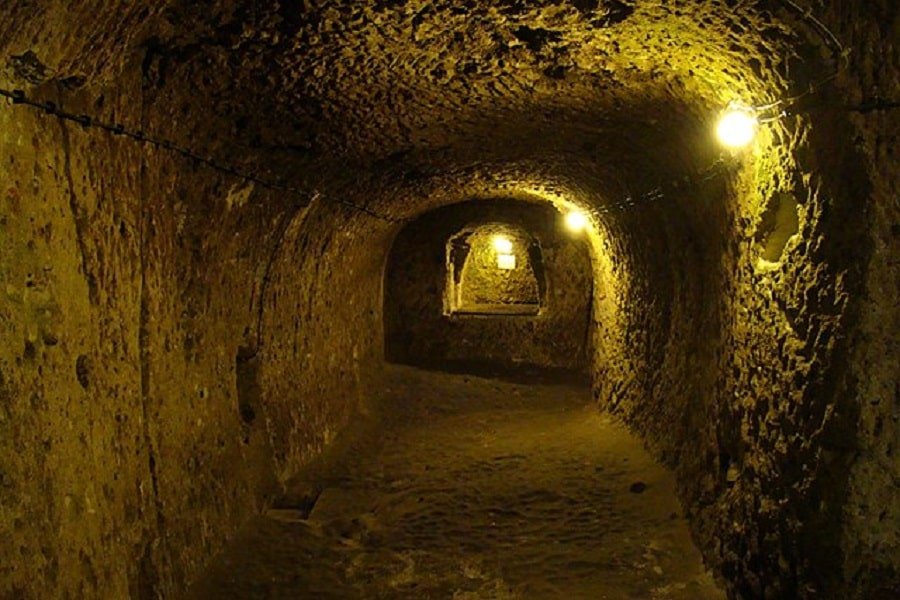 https://hicoop.b-cdn.net/wp-content/uploads/2023/07/underground-cities-Derinkuyu-300x200.jpg 300w, https://hicoop.b-cdn.net/wp-content/uploads/2023/07/underground-cities-Derinkuyu-768x512.jpg 768w" alt="underground-cities-Derinkuyu" width="900" height="600" data-lazy-srcset="https://hicoop.b-cdn.net/wp-content/uploads/2023/07/underground-cities-Derinkuyu.jpg 900w, https://hicoop.b-cdn.net/wp-content/uploads/2023/07/underground-cities-Derinkuyu-300x200.jpg 300w, https://hicoop.b-cdn.net/wp-content/uploads/2023/07/underground-cities-Derinkuyu-768x512.jpg 768w" data-lazy-sizes="(max-width: 900px) 100vw, 900px" data-lazy-src="https://hicoop.b-cdn.net/wp-content/uploads/2023/07/underground-cities-Derinkuyu.jpg" data-ll-status="loaded" />
https://hicoop.b-cdn.net/wp-content/uploads/2023/07/underground-cities-Derinkuyu-300x200.jpg 300w, https://hicoop.b-cdn.net/wp-content/uploads/2023/07/underground-cities-Derinkuyu-768x512.jpg 768w" alt="underground-cities-Derinkuyu" width="900" height="600" data-lazy-srcset="https://hicoop.b-cdn.net/wp-content/uploads/2023/07/underground-cities-Derinkuyu.jpg 900w, https://hicoop.b-cdn.net/wp-content/uploads/2023/07/underground-cities-Derinkuyu-300x200.jpg 300w, https://hicoop.b-cdn.net/wp-content/uploads/2023/07/underground-cities-Derinkuyu-768x512.jpg 768w" data-lazy-sizes="(max-width: 900px) 100vw, 900px" data-lazy-src="https://hicoop.b-cdn.net/wp-content/uploads/2023/07/underground-cities-Derinkuyu.jpg" data-ll-status="loaded" />Located in the historic Cappadocia region of Turkey, Derinkuyu is one of the largest underground cities in the world. This fascinating city was discovered in 1963 and is believed to have been built around the 8th century BC. Derinkuyu consists of 18 levels and was capable of housing around 20,000 people along with its livestock and storage facilities.
The city was designed with an intricate ventilation system, water wells, and meeting halls. What makes Derinkuyu even more intriguing is its connection to other underground cities through a series of tunnels, serving as an entire underground network.
Various civilizations, including the Hittites, Byzantines, and Ottomans, utilized this ancient city primarily as a hiding place in times of war.
2. Ħal Saflieni Hypogeum: The Subterranean Temple in Malta
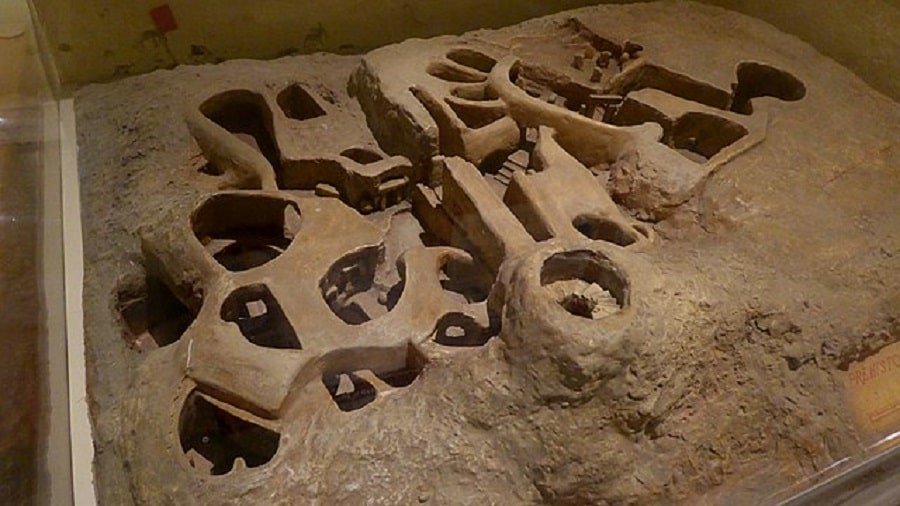 https://hicoop.b-cdn.net/wp-content/uploads/2023/07/Hal-Saflieni-Hypogeum-300x169.jpg 300w, https://hicoop.b-cdn.net/wp-content/uploads/2023/07/Hal-Saflieni-Hypogeum-768x432.jpg 768w" alt="Hal-Saflieni-Hypogeum" width="900" height="506" data-lazy-srcset="https://hicoop.b-cdn.net/wp-content/uploads/2023/07/Hal-Saflieni-Hypogeum.jpg 900w, https://hicoop.b-cdn.net/wp-content/uploads/2023/07/Hal-Saflieni-Hypogeum-300x169.jpg 300w, https://hicoop.b-cdn.net/wp-content/uploads/2023/07/Hal-Saflieni-Hypogeum-768x432.jpg 768w" data-lazy-sizes="(max-width: 900px) 100vw, 900px" data-lazy-src="https://hicoop.b-cdn.net/wp-content/uploads/2023/07/Hal-Saflieni-Hypogeum.jpg" data-ll-status="loaded" />Model of the Ħal-Saflieni Hypogeum at the National Museum of Archaeology in Valletta, Malta
https://hicoop.b-cdn.net/wp-content/uploads/2023/07/Hal-Saflieni-Hypogeum-300x169.jpg 300w, https://hicoop.b-cdn.net/wp-content/uploads/2023/07/Hal-Saflieni-Hypogeum-768x432.jpg 768w" alt="Hal-Saflieni-Hypogeum" width="900" height="506" data-lazy-srcset="https://hicoop.b-cdn.net/wp-content/uploads/2023/07/Hal-Saflieni-Hypogeum.jpg 900w, https://hicoop.b-cdn.net/wp-content/uploads/2023/07/Hal-Saflieni-Hypogeum-300x169.jpg 300w, https://hicoop.b-cdn.net/wp-content/uploads/2023/07/Hal-Saflieni-Hypogeum-768x432.jpg 768w" data-lazy-sizes="(max-width: 900px) 100vw, 900px" data-lazy-src="https://hicoop.b-cdn.net/wp-content/uploads/2023/07/Hal-Saflieni-Hypogeum.jpg" data-ll-status="loaded" />Model of the Ħal-Saflieni Hypogeum at the National Museum of Archaeology in Valletta, MaltaThe Ħal Saflieni Hypogeum in Malta is an ancient underground complex dating back to 4000 BC. It is considered one of the best-preserved prehistoric sites in the world, and in 1980, it was declared a UNESCO World Heritage Site.
This incredible structure features multiple levels and chambers, intricately carved out of limestone rock. The Hypogeum served as both a burial site and a place for ritualistic purposes.
Its beautifully sculpted chambers hold the remains of over 7,000 individuals. The most captivating aspect of this site, however, is the unique acoustic properties found within its “oracle chamber,” where sound resonates at extraordinary frequencies and produces a distinct acoustic effect.
3. Wieliczka Salt Mine: The Underground Kingdom in Poland
https://hicoop.b-cdn.net/wp-content/uploads/2023/07/Wieliczka-Salt-Mine-300x200.jpg 300w, https://hicoop.b-cdn.net/wp-content/uploads/2023/07/Wieliczka-Salt-Mine-768x512.jpg 768w" data-lazy-sizes="(max-width: 900px) 100vw, 900px" data-lazy-src="https://hicoop.b-cdn.net/wp-content/uploads/2023/07/Wieliczka-Salt-Mine.jpg" />The Wieliczka Salt Mine, located just outside of Kraków, Poland, is a massive subterranean site that has been in continuous operation since the 13th century. With nine levels stretching down over 327 meters, this site has produced an astonishing 200 million metric tons of rock salt.
Today, Wieliczka Salt Mine is a popular tourist attraction, offering guided tours through its historical and mythical chambers. Within this underground kingdom, you’ll find stunning salt sculptures, including the famous Last Supper and several salt-mineral chandeliers.
The mine also houses a health resort where visitors can undergo halotherapy treatments, which are believed to alleviate various respiratory issues and skin conditions.
4. Coober Pedy: The Opal Capital of the World, in Australia
https://hicoop.b-cdn.net/wp-content/uploads/2023/07/Coober-Pedy-300x200.jpg 300w, https://hicoop.b-cdn.net/wp-content/uploads/2023/07/Coober-Pedy-768x512.jpg 768w" data-lazy-sizes="(max-width: 900px) 100vw, 900px" data-lazy-src="https://hicoop.b-cdn.net/wp-content/uploads/2023/07/Coober-Pedy.jpg" />In the heart of the South Australian desert lies the unusual town of Coober Pedy. Known as the opal capital of the world, this subterranean settlement is centered around opal mining and production. It was established in 1915 when the first opal was discovered in the area.
With the incredibly harsh climate above ground, most of the town’s population has opted to live in the cool comfort of underground “dugout” homes.
An estimated 1,500 residents live beneath the surface in these cave-like dwellings, complete with modern amenities. The town also boasts underground hotels, shops, restaurants, and even a church, making it a truly unique destination for travelers seeking an unusual adventure.
5. Burlington: The Secret Underground City in England
Beneath the quiet English countryside, shrouded in secrecy, lies one of the most well-known underground cities that was constructed in the late 1950s during the height of the Cold War. Known as Burlington, this hidden underground bunker was designed to house and protect the British Government in case of a nuclear attack.
Sprawling over 35 acres and extending around 60 meters below the surface, Burlington was equipped to sustain 4,000 government officials and staff members for up to three months.
It also contained communication centers, a hospital, a broadcasting studio, and even an underground lake to provide fresh water. While the site was decommissioned in the early 2000s, it remains an intriguing example of Cold War-era planning and secrecy.
6. The Underground City of Naours
https://hicoop.b-cdn.net/wp-content/uploads/2023/07/Naours-300x200.jpg 300w, https://hicoop.b-cdn.net/wp-content/uploads/2023/07/Naours-768x512.jpg 768w" data-lazy-sizes="(max-width: 900px) 100vw, 900px" data-lazy-src="https://hicoop.b-cdn.net/wp-content/uploads/2023/07/Naours.jpg" />Located in the Picardy region of northern France, this subterranean city boasts an extensive network of tunnels and chambers. Dating back to the 3rd century AD, this extraordinary sanctuary was created as a haven from waves of ruthless invaders, including fearless Vikings and unstoppable Normans, who welcomed the residents with open arms.
In the two World Wars, it served as a hiding place and hospital. The 3-kilometer-long complex consists of nearly 300 rooms, chapels, stables, and workshops, and held around 3000 people at its peak.
READ MORE: What Caused World War 1? Political, Imperialistic, and Nationalistic Factors
7. Beijing Underground City: The Cold War-Era Shelter in China
https://hicoop.b-cdn.net/wp-content/uploads/2023/07/Beijing-Underground-City-300x188.jpg 300w, https://hicoop.b-cdn.net/wp-content/uploads/2023/07/Beijing-Underground-City-768x480.jpg 768w" data-lazy-sizes="(max-width: 900px) 100vw, 900px" data-lazy-src="https://hicoop.b-cdn.net/wp-content/uploads/2023/07/Beijing-Underground-City.jpg" />A map of Beijing underground cityConstructed in the 1960s and 1970s, the Beijing Underground City at Qianmen was built to safeguard the citizens of the city from anticipated air assaults and military conflicts.
Spanning over 85 square kilometers beneath the city’s streets, the complex featured an intricate network of tunnels, communication centers, hospitals, schools, and living quarters.
Today, portions of the Beijing Underground City have been opened to tourists, providing a unique look into China’s Cold War history.
8. Setenil de las Bodegas: The Town Beneath the Rocks in Spain
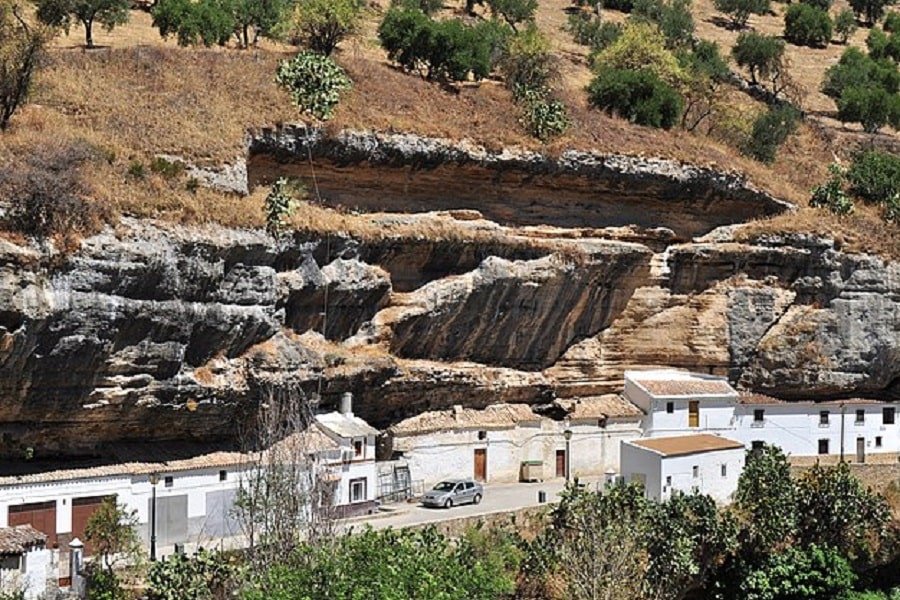 https://hicoop.b-cdn.net/wp-content/uploads/2023/07/Setenil-de-las-Bodegas-300x200.jpg 300w, https://hicoop.b-cdn.net/wp-content/uploads/2023/07/Setenil-de-las-Bodegas-768x512.jpg 768w" alt="Setenil-de-las-Bodegas" width="900" height="600" data-lazy-srcset="https://hicoop.b-cdn.net/wp-content/uploads/2023/07/Setenil-de-las-Bodegas.jpg 900w, https://hicoop.b-cdn.net/wp-content/uploads/2023/07/Setenil-de-las-Bodegas-300x200.jpg 300w, https://hicoop.b-cdn.net/wp-content/uploads/2023/07/Setenil-de-las-Bodegas-768x512.jpg 768w" data-lazy-sizes="(max-width: 900px) 100vw, 900px" data-lazy-src="https://hicoop.b-cdn.net/wp-content/uploads/2023/07/Setenil-de-las-Bodegas.jpg" data-ll-status="loaded" />
https://hicoop.b-cdn.net/wp-content/uploads/2023/07/Setenil-de-las-Bodegas-300x200.jpg 300w, https://hicoop.b-cdn.net/wp-content/uploads/2023/07/Setenil-de-las-Bodegas-768x512.jpg 768w" alt="Setenil-de-las-Bodegas" width="900" height="600" data-lazy-srcset="https://hicoop.b-cdn.net/wp-content/uploads/2023/07/Setenil-de-las-Bodegas.jpg 900w, https://hicoop.b-cdn.net/wp-content/uploads/2023/07/Setenil-de-las-Bodegas-300x200.jpg 300w, https://hicoop.b-cdn.net/wp-content/uploads/2023/07/Setenil-de-las-Bodegas-768x512.jpg 768w" data-lazy-sizes="(max-width: 900px) 100vw, 900px" data-lazy-src="https://hicoop.b-cdn.net/wp-content/uploads/2023/07/Setenil-de-las-Bodegas.jpg" data-ll-status="loaded" />Tucked away in the Andalusian region of Spain, Setenil de las Bodegas is a charming town built directly into the side of a cliff. The dwellings here are literally carved into the rock, with their overhanging cliffs providing natural shelter and insulation.
The town’s unique architecture dates back to the 12th century, and it was once a thriving Moorish settlement.
Today, Setenil de las Bodegas is a popular tourist destination, offering visitors a chance to explore winding streets lined with tapas bars, shops, and spectacular views of the surrounding countryside.
9. Nushabad: The Underground Oasis in Iran
https://hicoop.b-cdn.net/wp-content/uploads/2023/07/Nushabad-300x139.jpg 300w, https://hicoop.b-cdn.net/wp-content/uploads/2023/07/Nushabad-768x355.jpg 768w" data-lazy-sizes="(max-width: 900px) 100vw, 900px" data-lazy-src="https://hicoop.b-cdn.net/wp-content/uploads/2023/07/Nushabad.jpg" />In the arid landscapes of Iran lies the ancient underground city of Nushabad. Also known as Ouyi, this impressive three-story subterranean complex dates back to the Sasanian Empire (224-651 AD). The city was carved out of the ground to provide protection from invasions and to offer a secure shelter against the region’s harsh weather conditions.
Nushabad features a sophisticated ventilation system, water wells, various chambers for living and storage, and a labyrinth of interconnected tunnels, which helped to confuse potential intruders.
READ MORE: Who Invented Water? History of the Water Molecule
During the sweltering summer months, the inhabitants of Nushabad use the thousand-year-old sections of Nushabad for storage and shelter.
10. Petra: The Rose City in Jordan
https://hicoop.b-cdn.net/wp-content/uploads/2023/06/petra-royal-tombs-300x200.jpg 300w, https://hicoop.b-cdn.net/wp-content/uploads/2023/06/petra-royal-tombs-768x512.jpg 768w" data-lazy-sizes="(max-width: 900px) 100vw, 900px" data-lazy-src="https://hicoop.b-cdn.net/wp-content/uploads/2023/06/petra-royal-tombs.jpg" />The ancient city of Petra in Jordan, also known as the “Rose City” due to its pink sandstone cliffs, is a breathtaking example of a partially underground city. The Nabatean people built Petra around 600 BC, featuring elaborate rock-cut architecture that includes tombs, temples, and living quarters.
The most famous monument in Petra is the Treasury (Al-Khazneh), a stunning façade carved directly into the cliffside. Other main attractions include the Monastery (Ad-Deir), the Royal Tombs, and the Street of Facades.
In 1985, Petra was declared a UNESCO World Heritage Site, and today, it remains one of the most visited tourist destinations in the world.
11. Moose Jaw Tunnels: The Rum-Run Hideout in Canada
Located in the city of Moose Jaw, Saskatchewan, Canada, lies a network of underground tunnels that played an important role during the Prohibition era of the 1920s and early 1930s.
The tunnels connected many of the city’s downtown buildings, providing hidden transport paths for illegal goods such as alcohol and contraband.
The so-called “Chicago Connection” tells tales of notorious gangster Al Capone using these tunnels to run his bootlegging operations. Today, visitors can experience a guided tour of the tunnels and learn about Moose Jaw’s fascinating history of rum-running and organized crime.
12. Orvieto: The Italian Underground City
https://hicoop.b-cdn.net/wp-content/uploads/2023/07/Orvieto-300x168.jpg 300w, https://hicoop.b-cdn.net/wp-content/uploads/2023/07/Orvieto-768x430.jpg 768w" data-lazy-sizes="(max-width: 900px) 100vw, 900px" data-lazy-src="https://hicoop.b-cdn.net/wp-content/uploads/2023/07/Orvieto.jpg" />Perched atop a volcanic rock in Umbria, Italy, the city of Orvieto captivates visitors with its vast array of subterranean attractions. Beneath the city’s streets, a complex network of more than 1,200 caves, wells, tunnels, and galleries reveals Orvieto’s rich history.
The Etruscans originally inhabited this place in the 9th century BC, and many underground features, such as cisterns and tombs, trace back to that period.
The impressive St. Patrick’s Well (Pozzo di San Patrizio), which was completed in 1537, descends 62 meters deep and is a striking example of Renaissance engineering.
From ancient wineries to pigeon-breeding spaces, Orvieto’s underground city offers an incredible journey through time.
13. La Ville Souterraine: The Underground City in Montreal, Canada
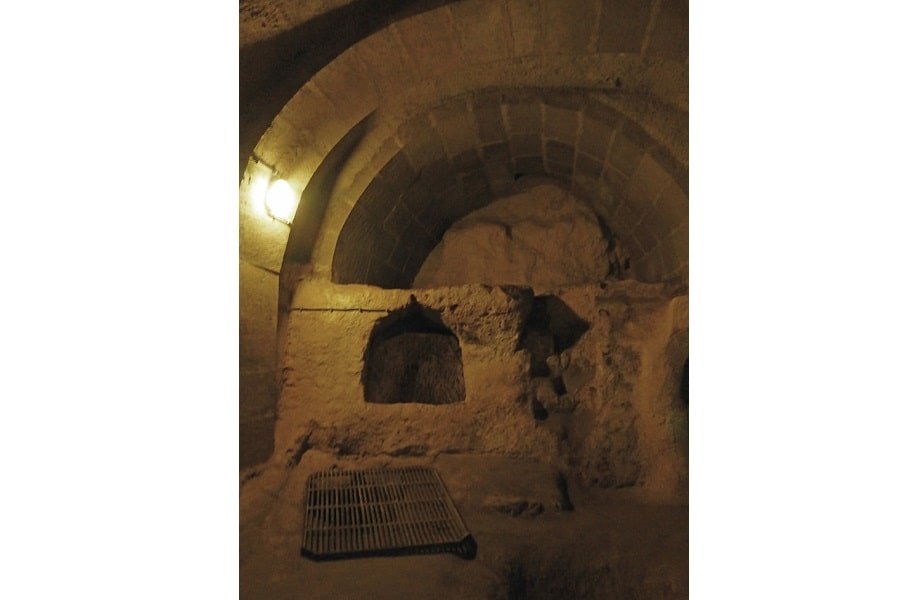 https://hicoop.b-cdn.net/wp-content/uploads/2023/07/La-Ville-Souterraine-300x200.jpg 300w, https://hicoop.b-cdn.net/wp-content/uploads/2023/07/La-Ville-Souterraine-768x512.jpg 768w" alt="La-Ville-Souterraine" width="900" height="600" data-lazy-srcset="https://hicoop.b-cdn.net/wp-content/uploads/2023/07/La-Ville-Souterraine.jpg 900w, https://hicoop.b-cdn.net/wp-content/uploads/2023/07/La-Ville-Souterraine-300x200.jpg 300w, https://hicoop.b-cdn.net/wp-content/uploads/2023/07/La-Ville-Souterraine-768x512.jpg 768w" data-lazy-sizes="(max-width: 900px) 100vw, 900px" data-lazy-src="https://hicoop.b-cdn.net/wp-content/uploads/2023/07/La-Ville-Souterraine.jpg" data-ll-status="loaded" />
https://hicoop.b-cdn.net/wp-content/uploads/2023/07/La-Ville-Souterraine-300x200.jpg 300w, https://hicoop.b-cdn.net/wp-content/uploads/2023/07/La-Ville-Souterraine-768x512.jpg 768w" alt="La-Ville-Souterraine" width="900" height="600" data-lazy-srcset="https://hicoop.b-cdn.net/wp-content/uploads/2023/07/La-Ville-Souterraine.jpg 900w, https://hicoop.b-cdn.net/wp-content/uploads/2023/07/La-Ville-Souterraine-300x200.jpg 300w, https://hicoop.b-cdn.net/wp-content/uploads/2023/07/La-Ville-Souterraine-768x512.jpg 768w" data-lazy-sizes="(max-width: 900px) 100vw, 900px" data-lazy-src="https://hicoop.b-cdn.net/wp-content/uploads/2023/07/La-Ville-Souterraine.jpg" data-ll-status="loaded" />La Ville Souterraine, or the Underground City, is a modern marvel located beneath the bustling streets of Montreal, Canada. Initially developed in 1962, this subterranean network now covers more than 32 kilometers of tunnels and spaces, connecting various commercial, retail, and transportation hubs.
With its climate-controlled environment and an extensive array of shops, restaurants, hotels, theaters, and office complexes, La Ville Souterraine offers a unique and convenient refuge for both residents and visitors from Montreal’s harsh winters.
However, it is interesting to note that the locals do not commonly use the term “La Ville Souterraine.” ‘The Underground City’ is the more commonly used term to refer to this network of interconnected tunnels and spaces.
14. Edinburgh Vaults: The Hidden Chambers in Scotland
https://hicoop.b-cdn.net/wp-content/uploads/2023/07/Edinburgh-Vaults-300x200.jpg 300w, https://hicoop.b-cdn.net/wp-content/uploads/2023/07/Edinburgh-Vaults-768x512.jpg 768w" data-lazy-sizes="(max-width: 900px) 100vw, 900px" data-lazy-src="https://hicoop.b-cdn.net/wp-content/uploads/2023/07/Edinburgh-Vaults.jpg" />Nestled beneath the bustling city of Edinburgh, Scotland, lies a series of hidden chambers known as the Edinburgh Vaults.
Constructed in the 18th century, these subterranean spaces were initially used as storage areas and workshops for businesses in the growing city. However, as the living conditions in the vaults deteriorated over time, they became a hub for illicit activities, including smuggling, brewing, and housing the city’s poor.
Today, guided tours of the Edinburgh Vaults offer visitors a chance to delve into the city’s darker history and explore the eerie, candlelit chambers and passages that still remain.
15. Matera: The Ancient Sassi in Italy
https://hicoop.b-cdn.net/wp-content/uploads/2023/07/Matera-300x200.jpg 300w, https://hicoop.b-cdn.net/wp-content/uploads/2023/07/Matera-768x512.jpg 768w" data-lazy-sizes="(max-width: 900px) 100vw, 900px" data-lazy-src="https://hicoop.b-cdn.net/wp-content/uploads/2023/07/Matera.jpg" />Situated in the southern Italian region of Basilicata, the city of Matera is home to a remarkable ancient settlement known as the Sassi. This UNESCO World Heritage Site comprises two districts, Sasso Caveoso and Sasso Barisano, which are filled with thousands of cave dwellings that were inhabited since the Paleolithic period.
READ MORE: Prehistory: Paleolithic, Mesolithic, Neolithic Periods, and More
These troglodyte homes, carved directly into the soft tuff rock, housed generations of families and their livestock, and featured cisterns for capturing rainwater. Now abandoned, the Sassi have undergone recent restoration efforts, transforming some of the caves into museums, hotels, and restaurants that help preserve Matera’s extraordinary history.
16. Catacombs of Rome: The Christian Burial Grounds in Italy
https://hicoop.b-cdn.net/wp-content/uploads/2023/07/Catacombs-of-Rome-300x200.jpg 300w, https://hicoop.b-cdn.net/wp-content/uploads/2023/07/Catacombs-of-Rome-768x512.jpg 768w" data-lazy-sizes="(max-width: 900px) 100vw, 900px" data-lazy-src="https://hicoop.b-cdn.net/wp-content/uploads/2023/07/Catacombs-of-Rome.jpg" />Beneath the ancient city of Rome lies a vast network of tunnels and chambers known as the Catacombs. Though not dubbed widely as underground cities, these underground burial sites date back to the 2nd century AD and primarily provided a resting place for early Christians, Jews, and other minority groups during the Roman Empire.
The Catacombs of Rome consist of several separate systems, such as the Catacombs of San Callisto, the Catacombs of San Sebastiano, and the Catacombs of Priscilla. Many of the tombs are adorned with intricate frescoes and sculptures, providing a glimpse into the lives and beliefs of the people who once called Rome home.
17. Pilsen Historical Underground: The Beer-Brewing City in the Czech Republic
The city of Pilsen, located in the Czech Republic, is renowned for its beer-brewing tradition, which has been going strong for centuries. Beneath the city streets, a 17 km-long network of underground cellars and tunnels tells the story of Pilsen’s beer-brewing heritage.
Constructed as early as the 14th century, these chambers provided storage for food and beverages, including beer barrels. The cool, constant temperatures of the Pilsen underground made it an ideal location for beer fermentation and storage. Today, visitors can partake in guided tours that highlight Pilsen’s rich brewing history and its intricate subterranean world.
18. Wrocław’s Underground Tourist Route: The WWII Shelters in Poland
Under Wrocław’s picturesque Main Square (Rynek), an extensive underground network of cellars and tunnels dates back to the medieval era. However, the most intriguing aspect of the Wrocław underground is its significance during World War II.
Under the surface, the Germans established a set of air-raid shelters, complete with gas-proof doors, ventilation systems, and sanitary facilities, which could accommodate around 300 people per bunker.
Today, the 300-meter-long Wrocław’s Underground Tourist Route allows visitors to venture beneath the city and explore the air raid shelters, medieval cellars, and temporary exhibition spaces.
19. Odessa Catacombs: The Mysterious Labyrinth in Ukraine
https://hicoop.b-cdn.net/wp-content/uploads/2023/07/Odessa-Catacombs-300x200.jpg 300w, https://hicoop.b-cdn.net/wp-content/uploads/2023/07/Odessa-Catacombs-768x512.jpg 768w" data-lazy-sizes="(max-width: 900px) 100vw, 900px" data-lazy-src="https://hicoop.b-cdn.net/wp-content/uploads/2023/07/Odessa-Catacombs.jpg" />Located beneath the city of Odessa, Ukraine, the Odessa Catacombs are a vast network of underground tunnels and chambers that originated in the 19th century as a result of the city’s limestone mining.
Though they are known to extend over 2,500 km, the exact measurements of the Catacombs are unknown due to their intricate nature.
The extensive subterranean labyrinth has, over time, served as a hiding place for criminals, a refuge for partisans during World War II, and a burial site for victims of violent conflicts. Nowadays, the labyrinth’s mysterious and eerie ambiance attracts tourists, who can explore limited sections through guided tours.
20. Lalibela: The Rock-Hewn Churches in Ethiopia
https://hicoop.b-cdn.net/wp-content/uploads/2023/07/Lalibela-300x200.jpg 300w, https://hicoop.b-cdn.net/wp-content/uploads/2023/07/Lalibela-768x512.jpg 768w" data-lazy-sizes="(max-width: 900px) 100vw, 900px" data-lazy-src="https://hicoop.b-cdn.net/wp-content/uploads/2023/07/Lalibela.jpg" />The town of Lalibela in Ethiopia is renowned for its series of incredible rock-hewn churches. Built in the 12th and 13th centuries by the order of King Lalibela, these monolithic churches were carved directly from the living rock. The site was intended to be a “New Jerusalem” for Ethiopian Christians and was of significant spiritual importance.
The eleven churches are interconnected through a network of tunnels, passages, and subterranean chambers. Notable churches include the Church of St. George (Bete Giyorgis), the Church of the Savior of the World (Bete Medhane Alem), and the Church of the Redeemer (Bete Golgotha Mikael).
Today, the site remains a pilgrimage destination and a designated UNESCO World Heritage Site.
READ MORE: How Did Christianity Spread: Origins, Expansion, and Impact
21. Umpherston Sinkhole: The Sunken Garden in Australia
In the town of Mount Gambier, South Australia, lies the enchanting Umpherston Sinkhole, also known as the Sunken Garden, which was created in 1886 by James Umpherston. He aimed to convert a massive limestone cave into a picturesque Victorian garden.
Descending from the ground level through a series of steps, visitors can explore the stunning subterranean oasis, complete with terraced gardens, tree ferns, hydrangeas, and even hanging ivy from the cave’s ceiling.
One distinct feature of the Umpherston Sinkhole is its resident colony of possums. At dusk, these nocturnal creatures emerge to feed on fruit left by visitors. Observing the possums adds to the charm and wildlife experience of the sinkhole in Australia.
22. Underground Atlanta: The Subterranean Shopping District in the United States
https://hicoop.b-cdn.net/wp-content/uploads/2023/07/Underground-Atlanta-300x200.jpg 300w, https://hicoop.b-cdn.net/wp-content/uploads/2023/07/Underground-Atlanta-768x512.jpg 768w" data-lazy-sizes="(max-width: 900px) 100vw, 900px" data-lazy-src="https://hicoop.b-cdn.net/wp-content/uploads/2023/07/Underground-Atlanta.jpg" />Situated below the streets of Atlanta, Georgia, in the United States, Underground Atlanta is a historic shopping district that initially served as the center of the city’s commercial life. Established in the late 19th century, the district comprised multiple levels, capitalizing on the natural slope of the terrain.
During the 20th century, the construction of a viaduct system left the original street level abandoned, and the area became neglected and obscure. In the 1960s, the site was rediscovered and revitalized into a vibrant indoor shopping and entertainment complex.
Today, Underground Atlanta, with its unique subterranean atmosphere, invites visitors to experience shopping, dining, and entertainment with a touch of history and nostalgia.
23. Slavonice Catacombs: Medieval Tunnels in the Czech Republic
The historical town of Slavonice, nestled in the South Bohemian region of the Czech Republic, boasts a remarkable series of medieval underground tunnels and cellars.
Constructed in the 12th and 13th centuries, these structures primarily served as storage facilities for various food items and beer. The expansive network stretches 2.5 kilometers below the town, with some cellars running three stories deep.
During World War II, Slavonice’s underground tunnels played a crucial role in the town’s defense strategy as part of the Czechoslovak border fortifications. A guided tour of the Slavonice Catacombs provides insight into the town’s architectural and military past and genuinely transports visitors to a different era.
24. Gilmerton Cove: The Mysterious Caverns in Scotland
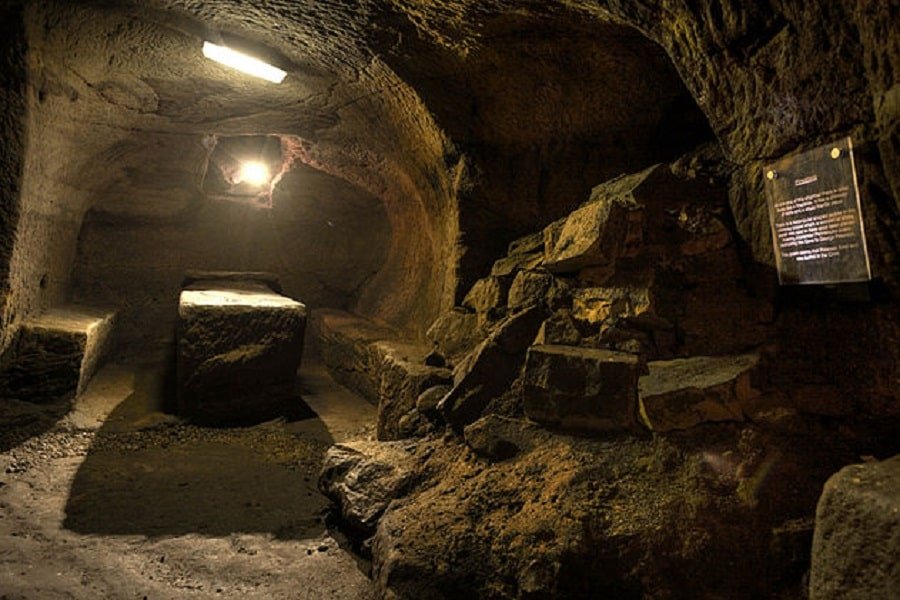 https://hicoop.b-cdn.net/wp-content/uploads/2023/07/Gilmerton-Cove-300x200.jpg 300w, https://hicoop.b-cdn.net/wp-content/uploads/2023/07/Gilmerton-Cove-768x512.jpg 768w" alt="Gilmerton-Cove" width="900" height="600" data-lazy-srcset="https://hicoop.b-cdn.net/wp-content/uploads/2023/07/Gilmerton-Cove.jpg 900w, https://hicoop.b-cdn.net/wp-content/uploads/2023/07/Gilmerton-Cove-300x200.jpg 300w, https://hicoop.b-cdn.net/wp-content/uploads/2023/07/Gilmerton-Cove-768x512.jpg 768w" data-lazy-sizes="(max-width: 900px) 100vw, 900px" data-lazy-src="https://hicoop.b-cdn.net/wp-content/uploads/2023/07/Gilmerton-Cove.jpg" data-ll-status="loaded" />
https://hicoop.b-cdn.net/wp-content/uploads/2023/07/Gilmerton-Cove-300x200.jpg 300w, https://hicoop.b-cdn.net/wp-content/uploads/2023/07/Gilmerton-Cove-768x512.jpg 768w" alt="Gilmerton-Cove" width="900" height="600" data-lazy-srcset="https://hicoop.b-cdn.net/wp-content/uploads/2023/07/Gilmerton-Cove.jpg 900w, https://hicoop.b-cdn.net/wp-content/uploads/2023/07/Gilmerton-Cove-300x200.jpg 300w, https://hicoop.b-cdn.net/wp-content/uploads/2023/07/Gilmerton-Cove-768x512.jpg 768w" data-lazy-sizes="(max-width: 900px) 100vw, 900px" data-lazy-src="https://hicoop.b-cdn.net/wp-content/uploads/2023/07/Gilmerton-Cove.jpg" data-ll-status="loaded" />On the outskirts of Edinburgh, Scotland, visitors can explore the enigmatic and intriguing underground chambers known as Gilmerton Cove. This subterranean complex consists of a series of interconnected rooms and passageways, all meticulously hand-carved from sandstone bedrock.
Despite extensive research, the exact age and purpose of Gilmerton Cove remain shrouded in mystery. Some theories suggest that it was once a 17th-century residential dwelling, while others propose connections to secret societies such as the Freemasons and the Knights Templar.
READ MORE: Secret Societies: Eleusinian Cult, The Knights Templar, and More!
Offering a sense of wonder and intrigue, a visit to Gilmerton Cove invites visitors to ponder the caverns’ enigmatic origins.
25. Fort Canning Bunker: War Relics in Singapore
https://hicoop.b-cdn.net/wp-content/uploads/2023/07/Fort-Canning-Bunker-300x200.jpg 300w, https://hicoop.b-cdn.net/wp-content/uploads/2023/07/Fort-Canning-Bunker-768x512.jpg 768w" data-lazy-sizes="(max-width: 900px) 100vw, 900px" data-lazy-src="https://hicoop.b-cdn.net/wp-content/uploads/2023/07/Fort-Canning-Bunker.jpg" />Hidden beneath the lush greenery of Fort Canning Park in Singapore lies a relic of the nation’s World War II history. Also known as the Battlebox, the Fort Canning Bunker, is a former underground military command center constructed in the 1930s by the British.
Comprising 26 rooms and two stories, this subterranean structure once served as the headquarters for British General Percival during the Battle of Singapore. Today, guided tours of the Fort Canning Bunker allow visitors to explore its well-preserved rooms, including a cipher room, telephone exchange, and air filtration system, and learn about Singapore’s wartime experience.
26. Kish: An Underground City on an Iranian Island
https://hicoop.b-cdn.net/wp-content/uploads/2023/07/Kish-300x200.jpg 300w, https://hicoop.b-cdn.net/wp-content/uploads/2023/07/Kish-768x512.jpg 768w" data-lazy-sizes="(max-width: 900px) 100vw, 900px" data-lazy-src="https://hicoop.b-cdn.net/wp-content/uploads/2023/07/Kish.jpg" />On the coral island of Kish in Iran lies a sprawling underground city with a rich history that dates back approximately 2,500 years. Initially built as an aqueduct system to collect and store fresh water, this underground city features a labyrinth of tunnels, chambers, and passageways characterized by their impressive arches and vaulted ceilings.
Following a careful restoration process, the site was opened to the public as a tourist attraction. Today, visitors can explore this intriguing subterranean city while learning about the ingenious engineering methods used by the ancient island dwellers who once relied on this aqueduct system to provide water in an otherwise inhospitable environment.
27. Belogradchik: Underworld Escapades in Bulgaria
https://hicoop.b-cdn.net/wp-content/uploads/2023/07/Belogradchik-300x200.jpg 300w, https://hicoop.b-cdn.net/wp-content/uploads/2023/07/Belogradchik-768x512.jpg 768w" data-lazy-sizes="(max-width: 900px) 100vw, 900px" data-lazy-src="https://hicoop.b-cdn.net/wp-content/uploads/2023/07/Belogradchik.jpg" />Belogradchik, a town located in the Vidin Province of Bulgaria, harbors an intriguing network of cave dwellings and underground habitations carved into its sandstone cliffs. These subterranean dwellings were inhabited as early as the 3rd century BCE, with various ancient civilizations, such as the Celts and the Romans, leaving their mark on the area’s history.
Visitors can explore a fascinating network of tunnels, caves, and settlements at the Belogradchik Fortress, a stronghold built into the natural landscape. The interconnectedness of these subterranean structures offers insights into the rich history of human habitation in the region.
28. Guanajuato City: Mexico’s Underground Passageways and Tunnels
Guanajuato City, in central Mexico, is known for its labyrinth of narrow streets, alleys, and tunnels that meander beneath the city’s colorful facades. The network of underground passageways was initially created to help drain water from the silver mines that were the city’s lifeblood during the Spanish colonial period.
READ MORE: Who Discovered America: The First People Who Reached the Americas
Over time, these tunnels have been adapted to serve as functional roadways and walkways, providing an alternative transportation method to the city’s bustling streets above.
Visitors to Guanajuato can experience these unique underground passageways while learning about the city’s vibrant history, rich in mining, silver trade, and Spanish colonial influences.
29. Kalachi: Underground Dwellings in Kazakhstan
In the remote village of Kalachi, situated in northern Kazakhstan, climate and geographical conditions have pushed residents to create underground dwellings for shelter and habitation. With oppressive heat and sandstorms during the summer months, living underground is often the only viable option.
The homes, known as “sardap,” are carved into the soil, providing natural thermal insulation and protection from the harsh elements above. Recognizing the potential of this subterranean habitat, the Kazakh government is offering support and resources to help preserve and develop these unique underground dwellings into residential and tourist attractions.
30. Fresnillo: Mexican City with a Subterranean Surprise
https://hicoop.b-cdn.net/wp-content/uploads/2023/07/Fresnillo-300x200.jpg 300w, https://hicoop.b-cdn.net/wp-content/uploads/2023/07/Fresnillo-768x512.jpg 768w" data-lazy-sizes="(max-width: 900px) 100vw, 900px" data-lazy-src="https://hicoop.b-cdn.net/wp-content/uploads/2023/07/Fresnillo.jpg" />You need to be a member of Ashtar Command - Spiritual Community to add comments!




Replies